Category Archives for Glazing
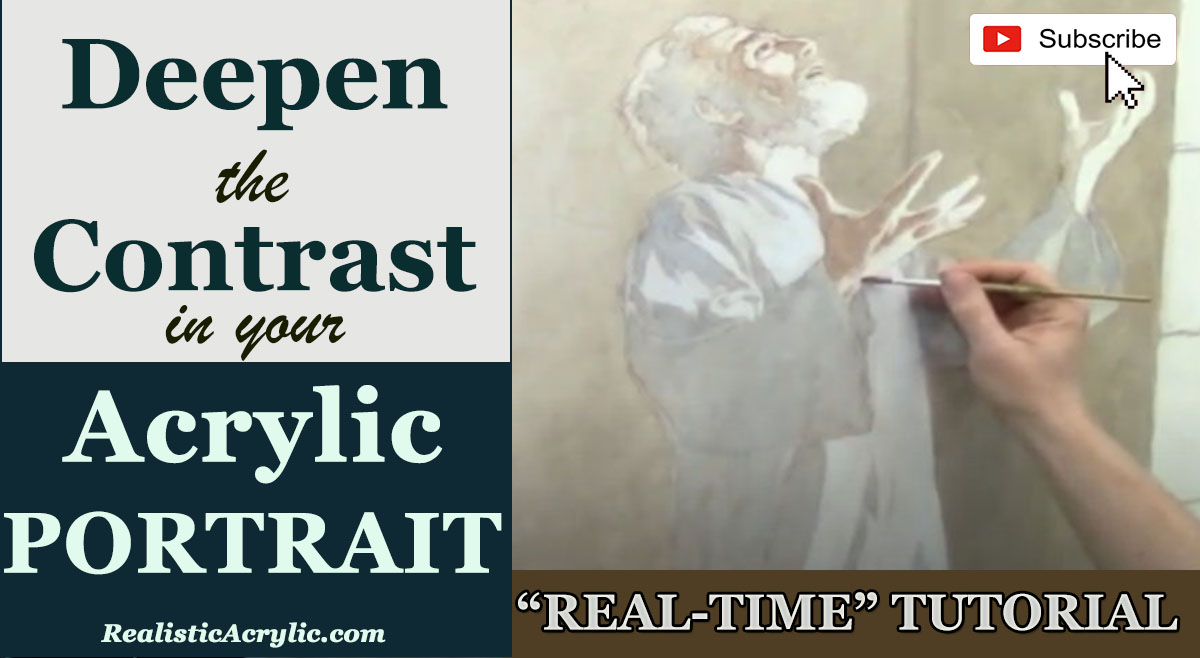
How to Deepen the Contrast in Your Acrylic
Elevate your acrylic art with advanced glazing techniques to achieve dramatic contrast and realism
Adding depth and contrast to your acrylic paintings is key to making your artwork pop with realism and vibrance. Because by employing advanced glazing techniques, you can enhance the dynamic range of values and create a compelling sense of depth. So in this post, we will explore how to deepen the contrast in your acrylic work, focusing on the effective use of glazing to build layers, define forms, and emphasize highlights.
What is Acrylic Glazing?
Acrylic glazing involves applying thin, translucent layers of paint to create depth, richness, and contrast in your painting. Because this technique allows the underpainting to show through, adding complexity to the colors and values. And then the glaze is typically made by mixing acrylic paint with a glazing medium, which thins the paint while maintaining its transparency.
Why Use Glazes for Contrast?
Glazing is one of the most effective ways to control contrast in acrylic painting. Instead of directly applying opaque colors, glazes allow you to build up subtle layers that gradually darken or lighten areas, depending on your goals. Then use darker glazes, you can add shadows and deepen contrast without losing the luminosity of the underpainting.
Step-by-Step: Deepening Contrast in an Acrylic Portrait
In this example, we will focus on a portrait painting of Daniel praying, because I will demonstrates how to apply multiple glazes to enhance contrast. And then we will use a combination of ultramarine blue, raw umber dark, and raw sienna to darken the background and make the highlights stand out. So let’s dive into the process.
1. Mixing Your Glaze
To begin, mix your glaze using ultramarine blue, raw umber dark, and raw sienna. This combination will create a deep, neutral tone perfect for adding contrast to the background. For better opacity, you can also add a touch of titanium white to the mix.
Tip: Always test your glaze on a scrap surface or a small section of the painting to ensure you achieve the desired transparency and color balance.
2. Applying the First Glaze
Once your glaze is ready, begin applying it to the background of the painting. Then use a flat-edged brush to smooth out the glaze evenly across the canvas, working in small sections. Think of it as painting a wall, applying consistent strokes to avoid streaking.
Be sure to “cut in” around the edges of the subject—here, Daniel’s hand and fingers. This creates a sharp definition between the background and the illuminated parts of the figure.
Tip: Don’t be afraid to overlap the glaze slightly onto the subject, if necessary, you can always wipe away excess glaze before it dries.
3. Smoothing the Glaze
After applying the glaze, use long, smooth strokes to blend it evenly across the surface. And the this will help eliminate any harsh lines or patches, ensuring a smooth transition between the background and the subject.
Tip: Apply firm pressure as you drag the brush along the contours of the form to ensure the glaze gets embedded into the canvas texture.
4. Adding Warmth Near the Light Source
In areas where light plays a key role, such as around a lamp or a torch in your painting, you’ll want to soften the glaze to allow for translucence. Mix in a little matte medium to dilute the glaze, creating a lighter, more transparent layer.
By using a warmer glaze—such as one mixed with red and yellow—around the light source, you can create the illusion of light emanating from the lamp. This technique will make your painting appear more vibrant and luminous.
5. Emphasizing Shadows on the Subject
Now that the background glaze is complete, you can focus on deepening the shadows on your subject. On Daniel’s face, for example, apply a glaze to the side of his nose, cheeks, and brow, adding depth to his facial features.
Tip: Study your reference photo carefully to observe how light interacts with the subject. In this case, Daniel’s head is tilted slightly backward, causing the light to illuminate the underside of his brow area. This requires a different shading approach than in typical portraits.
6. Maintaining Value Over Color
While color is important, value is even more critical when using glazes. So as you apply darker layers, ensure you leave the highlighted areas open for future glazing. Because this will prevent your painting from becoming muddy and ensure that your highlights maintain their vibrancy.
Tip: Avoid overcomplicating your glazes by adding too many colors at once. Focus on getting the values right first, then gradually build up the color intensity in later layers.
7. Layering and Blending
After adding the first few layers of glazes, assess the overall effect. You should start to see a sense of dimension forming, with contrasts between light and dark areas becoming more pronounced.
Continue building up layers of glaze to deepen the contrast further. For example, on Daniel’s hand, you can use a warmer glaze—like burnt sienna or alizarine crimson—to emphasize the structure and tension of his fingers, which are spread out in prayer.
Tip: Use a small round brush to add fine details, such as the tendons and veins in the hand. This will help convey a sense of movement and emotion in the painting.
8. Restoring Lost Highlights
As you apply darker glazes, you may occasionally lose some of the initial highlights. So do not worry—this can be easily fixed. Because it simply mix some titanium white with a glazing medium and go back over the highlighted areas, restoring the luminosity.
For example, in the area near the lamp, you may need to reapply a light glaze to ensure that the light source maintains its brightness and clarity. Doing this early in the process will save you from having to restore luminosity later, which can be more challenging.
Tips and Techniques for Successful Glazing
- Use Transparent Paints: Glazing works best with transparent pigments. Some good choices include ultramarine blue, raw sienna, and burnt sienna.
- Work in Layers: Glazing is a gradual process. Don’t rush to apply heavy layers. Instead, build up the depth of color and contrast slowly with thin applications.
- Dilute for Control: Use a matte or gloss medium to control the transparency of your glaze. Adding too much water can weaken the adhesive properties of acrylic paint.
- Focus on Value First: Always prioritize value over color when glazing. Ensuring the correct distribution of light and dark areas will make your painting more realistic and dynamic.
- Smooth with Pressure: Apply firm pressure when dragging your brush to ensure smooth transitions, especially in shadow areas.
Deepening the contrast in your acrylic paintings with glazing techniques not only adds depth but also brings life and realism to your artwork. By following these steps, you can effectively use glazes to define sharp edges, enhance shadows, and create glowing highlights. Remember, the key to glazing is patience and precision—each layer builds upon the last, contributing to the overall richness of the painting.
Experiment with different glaze mixtures, values, and pressures to achieve your desired effects, and then watch your painting come alive with contrast and clarity.
This technique of deepening contrast with glazes will transform your approach to acrylic painting. Then offering a powerful tool to create stunning, luminous portraits or any other subject you choose to paint.
If you’re looking for more instructional videos on how to improve your acrylic painting, visit www.realisticacrylic.com for more tutorials and check out my free courses here. .
LEARN MORE
- How to Paint Foliage Using the Acrylic Glazing Technique
- How to Trace for an Accurate Portrait Sketch
- How to Paint Realistic Eyes in Your Acrylic Portrait
- How to Add Raw Umber Dark & Ultramarine Blue to Your Portrait
- How to Make Your Own Raw Umber Dark
- How to Paint Realistic Trees & Grass in Your Acrylic
- How to Block In Skin Tone Values Using Glazing Technique
- How to Paint Vibrant Reds in Your Acrylic Portrait
- How to Glaze Background Colors & More Acrylic Portrait
- How to Paint White Clothing in Your Acrylic Portrait
- How to Easily Transition from a Sketch to a Painting
- How to Block In Shading & Skin Tones in Your Acrylic
- How to Build Up Color on Acrylic Pet Portrait
- How to Build Up Form on Clothing with Acrylic
- How to Paint Dark Clothing Using Acrylic Glazing Technique
- How to Paint a 24 x 30 Acrylic With 30 People
- How to Do Smooth Shading with Acrylic
- How to Sketch an Acrylic Portrait with a Grid
Read more about how to paint a portrait that you can surely be proud of!
I’d love to hear your thoughts on this video. Please share it with your friends and family. Let me know if you have any further questions. It’ll greatly help you.
If you’d like to learn more, sign up for my free email tips and video class today.
Learn How to Paint Acrylic Portraits With My Free Mini-Video Course!
Thank you so much for taking the time to read this tutorial and watch the video. That means a lot to me. I hope you find it very helpful in your portrait painting.
Yours for Better Portraits,

P.S. Did you find this post helpful or encouraging? If so, send it on ahead! Let others know with the share buttons below. I’d love to hear your comments. Thank you so much! Also, do you have a question on acrylic portrait painting you’d like answered? Let me know, and I’d be happy to help!
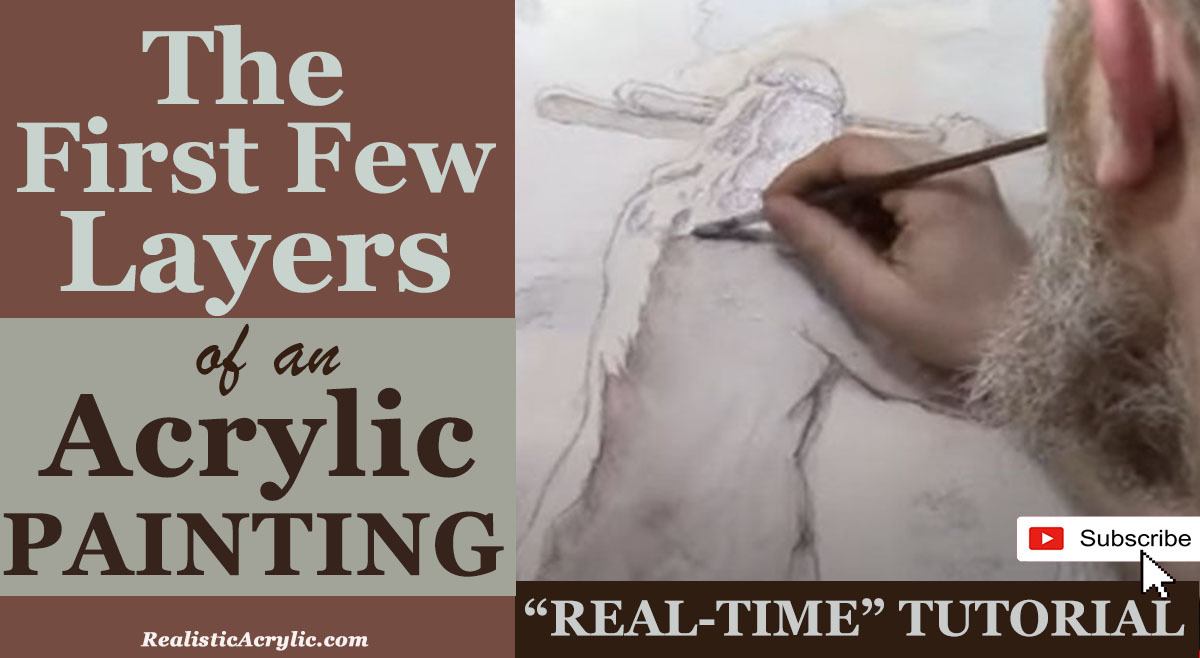
How to Paint Over a Detailed in First Few Layers of Acrylic
Learn the first few layers of acrylic glazing for depth and realism
Laying the Foundation with Acrylic Glazing
When it comes to portrait painting, the initial layers play a critical role in defining the composition, tone, and depth of the artwork. In this tutorial, we will explore how to paint over a detailed in first few layers of an acrylic portrait using the glazing technique. This method, often used by the old masters like Leonardo da Vinci and Titian, allows for the creation of subtle depth, rich shading, and enhanced realism.
In this lesson, we will delve into a commissioned piece depicting the biblical story of Moses, Aaron, and Hur during the ancient Israeli-Amalekite battle. The symbolism of this painting reflects intercessory prayer, where Moses’ raised staff determined the outcome of the battle, supported by Aaron and Hur. Let’s walk through the process of painting the first layers while maintaining the intricate details of the sketch.

Step 1: Blocking in the Shading
The first step in building up the painting is to block in the shading. Starting with a small flat brush, begin by mixing raw umber dark with a little ultramarine blue and blending it into matte medium. This mixture allows for transparent layering, known as glazing, which will help maintain the underlying sketch without disturbing its details.
- Tip: Use small amounts of acrylic paint mixed with large amounts of matte medium for best results. This creates translucent layers that gradually build depth.
As you apply this mixture, focus on blocking in the shadows and edges of the figure. In this case, we’re focusing on the figure of Moses. The goal here is not to add too much detail but to establish the overall value structure—the lights and darks that will give the portrait its dimensionality. Keep the paint wet and blend softly to avoid harsh lines.
Step 2: Maintaining the Integrity of the Sketch
One of the advantages of the glazing technique is that it allows you to retain the integrity of your detailed sketch. Unlike opaque painting methods, where the initial sketch can get lost under thick layers of paint, glazing preserves every line. This is especially helpful when working on complex portraits that require precision and subtlety.
- Technique: Build the layers slowly. The acrylic glazing method requires patience as each layer dries before the next is applied. This results in richer shading and more nuanced transitions between light and shadow.
Step 3: Applying the Glaze to the Headdress
After blocking in the shadows, it’s time to move on to more specific areas, such as Moses’ headdress. Here, switch to ultramarine blue for a cooler tone. Apply this thin glaze using a round brush, gently working it into the edges and interior details. The goal is to subtly enhance the color while maintaining the transparency of the paint.
- Tip: Always zoom in to focus on intricate details. This ensures that the smaller elements of your painting, such as folds in fabric or facial features, receive the attention they need.
By layering the blue glaze, you start to see the headdress take on more depth, creating a subtle contrast between the cool blues and the warmer tones of Moses’ skin.

Step 4: Blocking Out Old Elements
As with many paintings, revisions are often necessary. In this instance, the figure of Aaron needed to be moved to improve the overall composition. To block out the remnants of the previous version, use titanium white mixed with raw sienna. This combination will effectively cover up old lines and prepare the canvas for new elements.
- Technique: Blocking out sections with lighter colors helps create a clean slate for adjustments. Don’t be afraid to revisit areas that need correcting, as painting is a fluid process of refinement.
Step 5: Letting the Layers Dry
After applying the first few layers, it’s essential to let the painting dry. This is one of the key aspects of acrylic glazing—patience. Each layer needs time to set before the next one is applied to avoid muddying the colors or losing the delicate balance of transparency.
- Tip: Allow ample drying time between layers. This prevents the colors from blending unintentionally and helps you achieve the sharpness needed for realistic portraits.
Once the initial layers are dry, you can return to the painting to add further nuances and build upon the foundation you’ve created.
The Benefits of Acrylic Glazing
The glazing technique offers several advantages, especially for detailed portrait painting:
- Preservation of Details: Because you are working with thin layers of transparent paint, you can retain all the intricate details of your original sketch.
- Depth and Realism: Glazing allows for gradual transitions between light and shadow, creating a more lifelike and three-dimensional appearance.
- Low Pressure: Unlike opaque techniques, where you need to get the colors and values right on the first try, glazing offers more flexibility. Each layer builds upon the previous one, so mistakes can be easily corrected with additional glazes.
- Historical Significance: This technique has been used by master painters for centuries to achieve the luminous quality seen in classical portraits.
Conclusion: Building a Strong Foundation
Mastering the first few layers of an acrylic portrait is crucial to achieving depth and realism in your painting. When using the glazing technique, you can preserve the details of your sketch while gradually building up the shading and values. Because this method requires patience but ultimately results in a more nuanced and lifelike portrait.
If you’re interested in learning more about acrylic glazing or portrait painting techniques, be sure to explore the resources available at RealisticAcrylic.com. and download my free gift for you here. With practice, you’ll be able to master this technique and bring your portraits to life with rich depth and realism.
- Adding highlights to your acrylic painting
- 5 Excellent Reasons to Use Aluminum Foil
- Paint Realistic Wrinkles in Acrylic
- Painting Clothing in an Acrylic Portrait
- Paint a Cloudy Sky Acrylic
- How to add Semi-Opaque Highlights
- How to Enhance the Contrast in Your Acrylic
- How to Add Glaze to Your Acrylic Painting
- Paint Realistic Reflections on Eyeglasses in an Acrylic Portrait
- Build Up Depth on Your Acrylic Portrait Backgrounds
- How Do You Do Layers With the Glazing Technique?
- Learn How to Paint Wrinkles in Acrylic
Read more about how to paint a portrait that you can surely be proud of!
I’d love to hear your thoughts on this video. Please share it with your friends and family. Let me know if you have any further questions. I’ll greatly help you.
If you’d like to learn more, sign up for my free email tips and video class today.
Learn How to Paint Acrylic Portraits With My Free Mini-Video Course!
Thank you so much for taking the time to read this tutorial and watch the video. That means a lot to me. I hope you find it very helpful in your portrait painting.
Yours for Better Portraits,

P.S. Did you find this post helpful or encouraging? If so, send it on ahead! Let others know with the share buttons below. I’d love to hear your comments. Thank you so much! Also, do you have a question on acrylic portrait painting you’d like answered? Let me know, and I’d be happy to help!
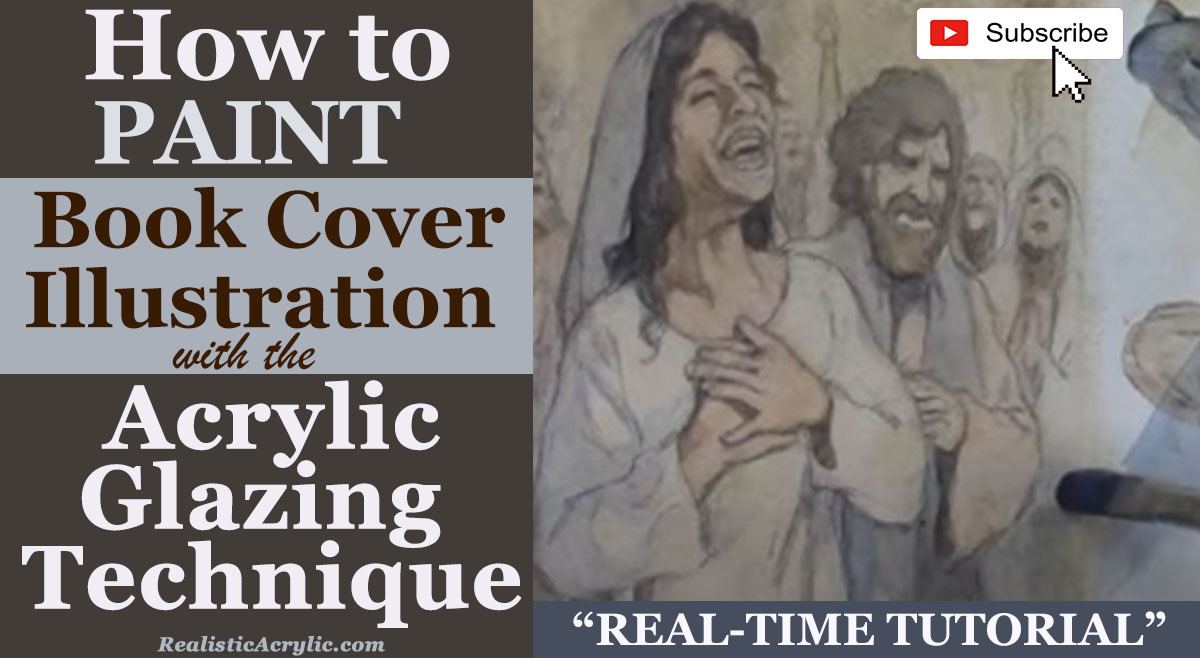
How to Paint a Book Cover Illustration: Glazing Technique
Learn the acrylic glazing technique to create stunning book cover Illustrations with depth and vibrancy
Creating a book cover illustration that tells a story visually and emotionally requires a combination of artistic skill, technique, and a deep understanding of the subject. In this tutorial, I’ll walk you through how to paint a book cover illustration using the acrylic glazing technique to achieve stunning results with rich depth, vibrant colors, and luminosity.
What is the Acrylic Glazing Technique?
The acrylic glazing technique involves applying multiple thin layers of translucent paint mixed with matte medium to create depth and a glowing, luminous effect. The glazing process allows light to pass through the layers, which builds color intensity and gives the painting a rich, oil-like appearance. It is perfect for capturing the complexity and atmosphere needed in book cover illustrations, where light, shadows, and vibrancy are essential.

Step-by-Step Guide to Creating a Book Cover Illustration with Glazing
Let’s dive into how I applied this method to paint a book cover illustration for a novel about the Holy Spirit falling on early disciples, based on the book of Acts. This is a spiritual and dramatic scene that requires both light and darkness to emphasize the event’s importance.
1. Start with a Detailed Sketch
To begin, create a detailed sketch of your composition. This is crucial because the glazing technique builds on these initial lines. You’ll want to ensure your sketch is solid, as each layer of glazing will enhance, rather than obscure, the underlying structure.
2. First Layer: Laying the Foundation
Mix a small amount of paint with a large amount of matte medium. This thins out the paint, making it semi-transparent. Apply the first layer of paint to your illustration, ensuring that your strokes are smooth and even. For my painting, I used a base of ultramarine blue and raw sienna to establish the shadows and overall color scheme. Keep the first few layers lighter since you will be building up darker values later.
3. Building Depth Through Dark Values
Once your foundation layer dries, it’s time to build depth. One of the keys to creating luminous, realistic paintings is the interplay between light and dark. In this painting, I focused on ultramarine blue to darken the upper portion, which depicts the dimly lit upper room, creating a stark contrast with the bright flames of the Holy Spirit that will appear later.
Dark values are critical because they allow the lighter, vibrant tones to pop. In the same way, darkness in our lives often brings out blessings. To achieve the desired darkness, slowly add layer upon layer of paint, waiting for each one to dry before applying the next.
4. Transitioning from Cool to Warm Tones
One essential tip when glazing is understanding how to transition between cool and warm tones. In darker areas, the colors tend to be cooler (think blues and purples), while lighter areas feature warmer colors (yellows, reds, and oranges). In this book cover illustration, the darker parts of the room had cool ultramarine blue tones, while the warmer Indian yellow tones were reserved for areas where the fire of the Holy Spirit would shine.
As you apply your glazes, notice how the colors transition and blend naturally, much like light transitioning into shadows. This technique is particularly useful in storytelling illustrations, where light represents hope or divine presence and shadows signify mystery or darkness.
5. Adding Glazes to Create Vibrancy
One of the significant benefits of the acrylic glazing technique is the vibrancy it adds to the painting. As you layer each glaze, you’ll notice that the colors start to shine more brightly, and the image becomes more saturated. This effect is especially noticeable when adding warmer colors, such as the burnt sienna and alizarine crimson for the clothing of the disciples.
The layering effect is like compounded interest in a bank account. Each layer builds upon the last, making the painting look increasingly vibrant. For example, I added green by mixing Indian yellow and ultramarine blue over a woman’s shawl, producing a rich, natural hue.
6. Balancing Colors for Harmony
When glazing, it’s essential to balance your colors across the canvas. If you add a specific color in one area, consider incorporating it elsewhere in the painting to create visual harmony. In this illustration, after applying green to the woman’s shawl, I used a similar hue in another figure’s clothing to achieve balance.
You can also experiment by mixing colors to create subtle, natural transitions. For instance, I mixed burnt sienna and alizarine crimson to add reddish tones to a male figure’s garment, giving it warmth without overpowering the surrounding colors.
7. Final Touches: Highlighting with Warm Glazes
After several layers of glazing, it’s time to add the final touches. For a book cover illustration like this, where the theme involves divine light, the final layers should include warm highlights that make the painting stand out. I used yellow ochre and white to capture the light reflecting off the disciples’ faces and the flames above their heads.
By keeping the upper layers thin, I ensured that the underlying colors remained visible, adding depth and creating a glowing effect. This is the essence of the acrylic glazing technique—allowing light to pass through layers of color, creating an ethereal and vibrant painting.
Tips and Techniques for Mastering the Acrylic Glazing Technique
- Use Matte Medium: Matte medium thins out the paint, making it translucent. The more matte medium you use, the more transparent the glaze will be.
- Work in Layers: Allow each layer to dry before applying the next. This helps you build up color gradually and maintain control over the final effect.
- Balance Warm and Cool Colors: Warmer tones pop against darker, cooler backgrounds. Be mindful of how these two temperature families interact on your canvas.
- Keep the Initial Layers Light: Your first few layers should be light to avoid losing detail. The glazing technique builds on transparency, allowing your sketch to remain visible.
- Experiment with Color Mixing: Combine different pigments with matte medium to create unique shades and effects. For instance, mixing Indian yellow with ultramarine blue produced a rich, green glaze in my painting.
Conclusion
The acrylic glazing technique is a powerful tool for artists who want to create paintings with depth, luminosity, and vibrancy. Whether you’re painting a book cover illustration or any other artwork, the layering process allows you to build color gradually while maintaining control over detail and tonal transitions. By practicing this method and applying the tips outlined above, you can take your painting skills to the next level.
For more in-depth tutorials on acrylic painting, visit Realistic Acrylic Portrait School and check out my free gift for you here
- Adding highlights to your acrylic painting
- 5 Excellent Reasons to Use Aluminum Foil
- Paint Realistic Wrinkles in Acrylic
- Painting Clothing in an Acrylic Portrait
- Paint a Cloudy Sky Acrylic
- How to add Semi-Opaque Highlights
- How to Enhance the Contrast in Your Acrylic
- How to Add Glaze to Your Acrylic Painting
- Paint Realistic Reflections on Eyeglasses in an Acrylic Portrait
- Build Up Depth on Your Acrylic Portrait Backgrounds
- How Do You Do Layers With the Glazing Technique?
- Learn How to Paint Wrinkles in Acrylic
Read more about how to paint a portrait that you can surely be proud of!
I’d love to hear your thoughts on this video. Please share it with your friends and family. Let me know if you have any further questions. I’ll greatly help you.
If you’d like to learn more, sign up for my free email tips and video class today.
Learn How to Paint Acrylic Portraits With My Free Mini-Video Course!
Thank you so much for taking the time to read this tutorial and watch the video. That means a lot to me. I hope you find it very helpful in your portrait painting.
Yours for Better Portraits,

P.S. Did you find this post helpful or encouraging? If so, send it on ahead! Let others know with the share buttons below. I’d love to hear your comments. Thank you so much! Also, do you have a question on acrylic portrait painting you’d like answered? Let me know, and I’d be happy to help!
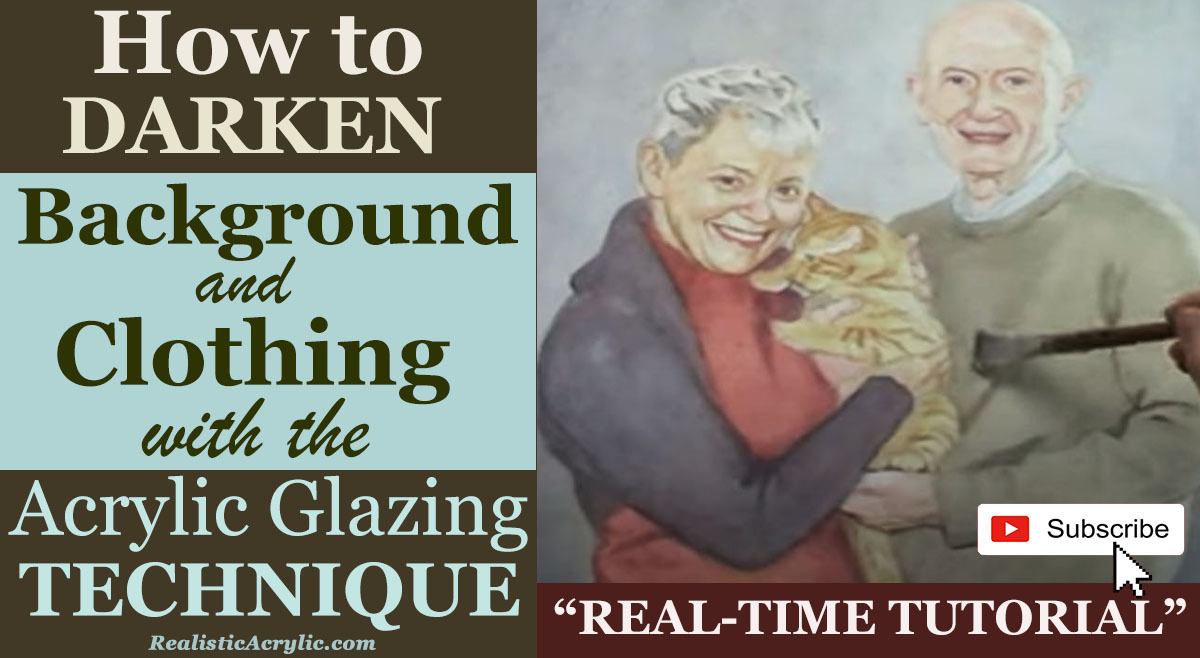
How To Darken Background & Clothing: Acrylic Glazing Technique
Discover the acrylic glazing technique to add depth, richness, and contrast to your portraits by darkening the background and clothing with ease.
One of the challenges portrait artists face is creating a balanced contrast between the subject and the background. Acrylic glazing is an excellent technique for solving this problem, offering the ability to subtly darken elements like the background and clothing while maintaining depth and luminosity. In this tutorial, we’ll explore how to use acrylic glazing to darken the background and clothing in your portraits. Then the key to success in this technique lies in building up light layers of color, allowing the paint to create a rich, oil-like effect that transforms your artwork.
Because at the end of this guide, you’ll be able to create striking contrasts, enhance the mood of your painting, and master acrylic glazing for darker tones.

Materials Needed
To achieve the best results with the acrylic glazing technique, you’ll need the following materials:
- Acrylic paints (ultramarine blue, burnt sienna, raw umber, titanium white, etc.)
- Matte medium (or glazing medium)
- Reference photo
- Various brushes (detail brushes, medium flat brush, and large round brush)
- Palette for mixing
- Water and a clean rag
Understanding Acrylic Glazing
Acrylic glazing is a technique where you mix a small amount of pigment with a large amount of matte medium to create thin, transparent layers of color. Each layer allows light to pass through, giving the painting added depth and richness. This technique mimics the effects of oil painting but with the faster drying time of acrylics, making it a versatile choice for many artists.
In this video, we follow the steps to darken the background and clothing of a 16×20 acrylic portrait of a couple and their cat. The key to achieving a smooth glaze is to ensure your base sketch is solid, allowing the layers to enhance rather than correct the painting.
Step 1: Starting with a Solid Sketch
Before applying glazes, it’s essential to have a strong and accurate sketch. As I have mention, that if you want to make sure that the proportions and likeness are perfect before you begin glazing. Because the foundation is key to a successful final product.
When creating your sketch:
- Focus on achieving correct proportions of your subject.
- Make sure the key areas such as the eyes, nose, and mouth are aligned.
- Use light pencil marks that won’t interfere with the transparency of your glaze.
Step 2: Mixing the First Glaze for the Background
In this painting, the client requested a bluish tone for the background. To create a blue glaze, follow these steps:
- Mix Ultramarine Blue: Add a small amount of ultramarine blue to your palette.
- Add Matte Medium: Mix the blue with matte medium until the paint is very translucent. Matte medium is milky white but dries completely clear, allowing the underlying layers to shine through.
- Apply the Glaze: Using short, choppy brush strokes, begin layering the blue glaze onto the background. This creates a smooth transition between the subject and background, enhancing depth.
One of the advantages of glazing is its flexibility. If the glaze looks too intense, you can always add more matte medium or water to lighten it.
Step 3: Building Up Contrast Between the Subject and Background
After applying the initial glaze, focus on enhancing the contrast between the subject (in this case, the couple and their cat) and the background. This step is crucial to making the subject stand out. You want to:
- Gradually increase the opacity of the glazes on the background to push it further into the distance.
- Use darker tones in the background compared to the foreground to create depth.
To darken the background even more, add layers of raw umber or burnt sienna mixed with matte medium on top of the blue glaze. This will give the background a more muted, shadowy effect while still allowing the initial blue tone to shine through.
Step 4: Glazing the Clothing
Next, shift focus to darkening the clothing using a similar glazing technique. The subject in this portrait is wearing darker-toned clothes, and I use the combination of raw umber and ultramarine blue to darken the clothing in a natural, gradual way.
- Mix Raw Umber and Blue: Combine raw umber with ultramarine blue and matte medium. This creates a nice neutral dark glaze that adds depth to the clothing without making it look flat.
- Apply the Glaze: Begin layering this darker glaze on the clothing, focusing on areas of shadow or where more depth is needed.
- Build Layer by Layer: Since glazing is a cumulative process, each layer adds more intensity to the clothing. Don’t worry about getting the perfect color right away. With each layer, the colors will mix and blend, creating a more realistic tone.
Remember, glazing allows you to make adjustments easily. If the color feels too cool or too warm, add a thin glaze of raw sienna or alizarin crimson to adjust the warmth or coolness.
Step 5: Enhancing Details and Finishing Touches
Once the base glazes are in place, use smaller detail brushes to enhance the finer areas, such as the edges of the clothing or folds in the fabric. For example, I use raw sienna to highlight certain areas of the shirt’s wrinkles. Then this subtle addition of color adds a lifelike quality to the painting.
At this stage, pay attention to:
- Wrinkles and folds in the clothing: Use a small brush to carefully apply thin glazes to highlight these details.
- Edge details: Glaze carefully around the edges where the subject meets the background, ensuring a smooth transition.
Tips for Acrylic Glazing Technique
- Use Light Layers: Always apply thin glazes and build up gradually. Heavy applications will obscure the previous layers.
- Dry Between Layers: Allow each glaze to dry before adding the next. This prevents muddying the colors.
- Experiment with Color: Don’t be afraid to adjust the color temperature with warm or cool glazes.
- Less Is More: A little pigment goes a long way when glazing. Be mindful of how much color you mix in with the medium.
- Work from Light to Dark: Build up your painting by working from lighter glazes to darker ones to maintain luminosity and depth.
Conclusion
The acrylic glazing technique offers artists a powerful tool for adding depth and richness to their paintings. When layering transparent color, you can gradually darken backgrounds and clothing without losing the vibrancy of the initial layers. This method also allows for flexibility, as adjustments can be made throughout the process without the pressure of getting it right on the first try.
In this painting of a couple and their cat, the careful use of glazing brings out the contrast between the subjects and their background, creating a compelling portrait. With practice, you’ll be able to master this technique and apply it to your own projects, transforming your portraits into luminous works of art.
If you’re looking for more instructional videos on how to improve your acrylic painting, visit www.realisticacrylic.com for more tutorials and check out my free courses here. .
- Adding highlights to your acrylic painting
- 5 Excellent Reasons to Use Aluminum Foil
- Paint Realistic Wrinkles in Acrylic
- Painting Clothing in an Acrylic Portrait
- Paint a Cloudy Sky Acrylic
- How to add Semi-Opaque Highlights
- How to Enhance the Contrast in Your Acrylic
- How to Add Glaze to Your Acrylic Painting
- Paint Realistic Reflections on Eyeglasses in an Acrylic Portrait
- Build Up Depth on Your Acrylic Portrait Backgrounds
- How Do You Do Layers With the Glazing Technique?
- Learn How to Paint Wrinkles in Acrylic
Read more about how to paint a portrait that you can surely be proud of!
I’d love to hear your thoughts on this video. Please share it with your friends and family. Let me know if you have any further questions. I’ll greatly help you.
If you’d like to learn more, sign up for my free email tips and video class today.
Learn How to Paint Acrylic Portraits With My Free Mini-Video Course!
Thank you so much for taking the time to read this tutorial and watch the video. That means a lot to me. I hope you find it very helpful in your portrait painting.
Yours for Better Portraits,

P.S. Did you find this post helpful or encouraging? If so, send it on ahead! Let others know with the share buttons below. I’d love to hear your comments. Thank you so much! Also, do you have a question on acrylic portrait painting you’d like answered? Let me know, and I’d be happy to help!
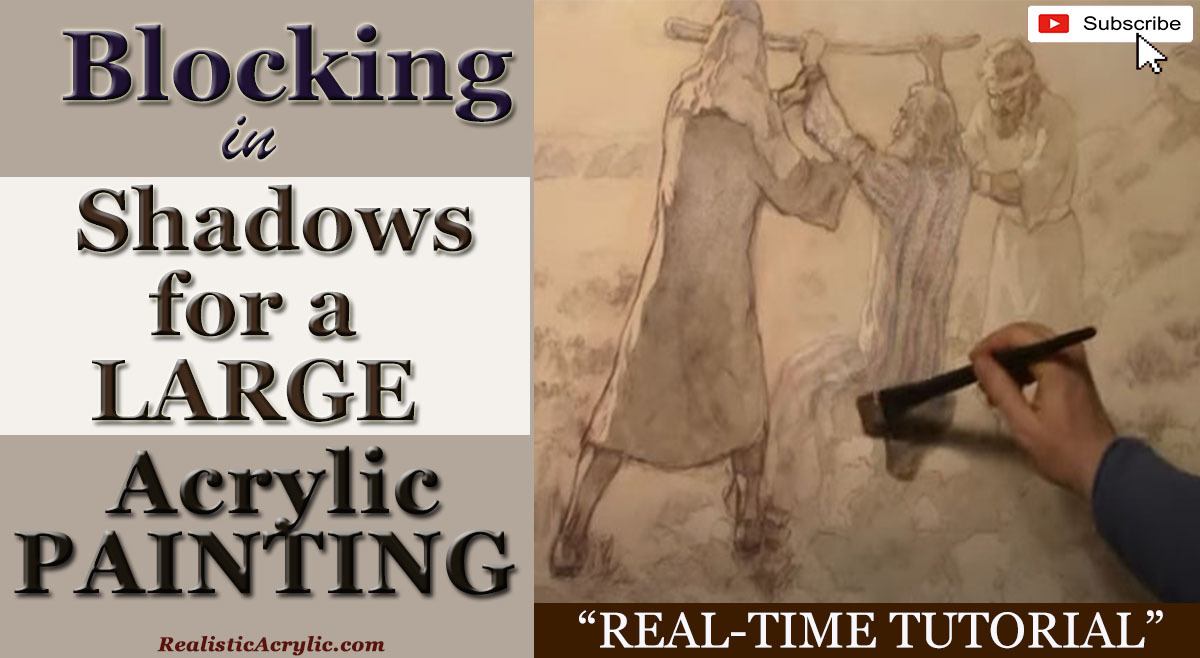
How to Blocking in Shadows for a LARGE Painting
Learn the art of blocking shadows with acrylic glazing for dramatic depth in large paintings
When creating a large acrylic painting, one of the key elements in bringing it to life is mastering the shadow work. Blocking in shadows helps define the structure and form of your subject, adding realism and depth. Using an acrylic glazing technique enhances the shadowing effect, keeping it translucent while still maintaining control over the darker areas of the painting.
In this blog post, we’ll explore a step-by-step approach on how to block in shadows for a large painting. We’ll cover the essential tools, glazing methods, and tips to help you create a more dynamic, realistic piece of art.
Setting the Stage: Preparing for Shadow Blocking
Before diving into the painting process, it’s important to prepare your materials and mindset. I begin this painting session with a moment of reflection and prayer, setting an intention to create a work that captures emotion and depth. Preparation also involves setting up the canvas, sketching the outline of the subject, and sealing the sketch with a light glaze.
For this demonstration, a mixture of raw umber dark and ultramarine blue was chosen for the shadow work. These colors, when blended, create a rich, cool tone that is perfect for shadows. Here’s how you can apply this to your own painting:
- Prepare Your Canvas: Start with a white canvas, sketch your subject, and seal the sketch with a light glaze using diluted acrylic matte medium.
- Choose Your Colors: For shadows, a mix of raw umber dark and ultramarine blue works beautifully to create a cool-toned effect. These colors blend well and offer the right balance between transparency and opacity.
Step-by-Step: Blocking in Shadows
- Creating the First Glaze Layer
Begin by applying a diluted glaze over the areas where shadows will be present. For large paintings, it’s important to keep a wet edge during the application process to avoid streaks or unwanted lines. Using long, sweeping brushstrokes, layer the glaze in areas where you want shadows to appear. - Maintaining Translucency
The beauty of acrylic glazes is their translucent nature. You can still see the sketch beneath the glaze, preserving the fine details as you work on the shadows. To achieve this effect, ensure that your glaze mixture has more medium than pigment, allowing light to pass through. - Building the Tonal Value Structure
Blocking in shadows is more than just applying darker tones. It’s about understanding the value structure of your reference image. In the demonstration, the artist frequently checks his reference photo to ensure that he’s accurately representing the light and shadow interplay. Study your reference carefully and build the shadows from light to dark.- Tip: Cooler tones work well for shadows. Add a small amount of ultramarine blue to your glaze to give the shadows a cooler, more natural effect.
Techniques for Shadow Blocking in Large Paintings
Blocking in shadows for a large painting requires a few specialized techniques. Here are some essential methods to use:
- Layering Glazes for Depth
Rather than applying one thick layer, build your shadows gradually by adding multiple thin layers of glaze. This will help you control the depth and darkness of the shadow, while still maintaining the luminosity of the overall painting. - Vary Your Brush Strokes
As you apply the glaze, it’s helpful to vary the direction of your brushstrokes. This creates a more natural and organic look, especially in areas with fabric or textures like rocks. For example, the artist worked on the figure’s clothing, carefully brushing in the shadows to maintain the folds and creases. - Use a Smaller Brush for Detail
Once the large areas are blocked in, switch to a smaller brush to refine the edges of the shadows. This technique allows you to add subtle details that make the shadowing more realistic.
Key Tips and Techniques for Effective Shadow Work
- Keep a Wet Edge: When applying a glaze, always maintain a wet edge to prevent harsh lines and streaks. This will ensure smooth transitions between the light and shadowed areas.
- Use Cooler Tones: Shadows should be cooler in tone compared to the lighter areas. Adding a hint of ultramarine blue to your glaze helps achieve this effect.
- Layer Glazes for Control: Don’t rush the shadowing process. Build up the intensity gradually by applying thin layers of glaze until you reach the desired depth.
- Pay Attention to Gradation: Shadows are rarely uniform in tone. They often fade or blend into lighter areas. Adjust your glaze to create smooth gradations between light and dark.
Applying Glazes to Specific Elements
In the video, I focused on several parts of the painting and then demonstrated the blocking in of shadows:
- The Figure’s Clothing: By using a combination of raw umber dark and ultramarine blue, the artist darkened the folds of the figure’s clothing, preserving the highlights and lighter areas.
- The Rocks: Shadows were added to the rocks behind the main figures, using a slightly bolder application of glaze. The cooler tones gave the rocks a natural shadowed effect, which contrasted well with the lighter areas.
- Background Elements: Blocking in shadows for the background elements, such as the sky and distant stones, helps create a sense of depth and distance. In this case, the artist allowed the shadows to blend naturally into the lighter tones, creating a balanced contrast.
Finishing Touches: Refining the Shadows
Once the shadow areas are blocked in, the final step involves refining the details. Then I used a smaller brush to control the finer aspects of the shadows, ensuring that they didn’t overpower the highlights. This delicate balance between light and shadow is what ultimately brings the painting to life.
- Pro Tip: If a glaze feels too bold, you can always lighten it by gently brushing over the area with a bit of water or clear medium to soften the edges.
Conclusion: Mastering the Art of Shadow Blocking
Blocking in shadows is a crucial skill for any artist, especially when working on large paintings. By using acrylic glazing techniques, you can add depth and realism while preserving the underlying details. Remember to take your time, build the shadows in layers, and constantly refer to your reference photo to ensure accuracy.
Master this technique, and you’ll find your large acrylic paintings gaining new levels of dimension and realism.
If you’re looking for more instructional videos on how to improve your acrylic painting, visit www.realisticacrylic.com for more tutorials and check out my free courses here. .
- Adding highlights to your acrylic painting
- 5 Excellent Reasons to Use Aluminum Foil
- Paint Realistic Wrinkles in Acrylic
- Painting Clothing in an Acrylic Portrait
- Paint a Cloudy Sky Acrylic
- How to add Semi-Opaque Highlights
- How to Enhance the Contrast in Your Acrylic
- How to Add Glaze to Your Acrylic Painting
- Paint Realistic Reflections on Eyeglasses in an Acrylic Portrait
- Build Up Depth on Your Acrylic Portrait Backgrounds
- How Do You Do Layers With the Glazing Technique?
- Learn How to Paint Wrinkles in Acrylic
Read more about how to paint a portrait that you can surely be proud of!
I’d love to hear your thoughts on this video. Please share it with your friends and family. Let me know if you have any further questions. I’ll greatly help you.
If you’d like to learn more, sign up for my free email tips and video class today.
Learn How to Paint Acrylic Portraits With My Free Mini-Video Course!
Thank you so much for taking the time to read this tutorial and watch the video. That means a lot to me. I hope you find it very helpful in your portrait painting.
Yours for Better Portraits,

P.S. Did you find this post helpful or encouraging? If so, send it on ahead! Let others know with the share buttons below. I’d love to hear your comments. Thank you so much! Also, do you have a question on acrylic portrait painting you’d like answered? Let me know, and I’d be happy to help!
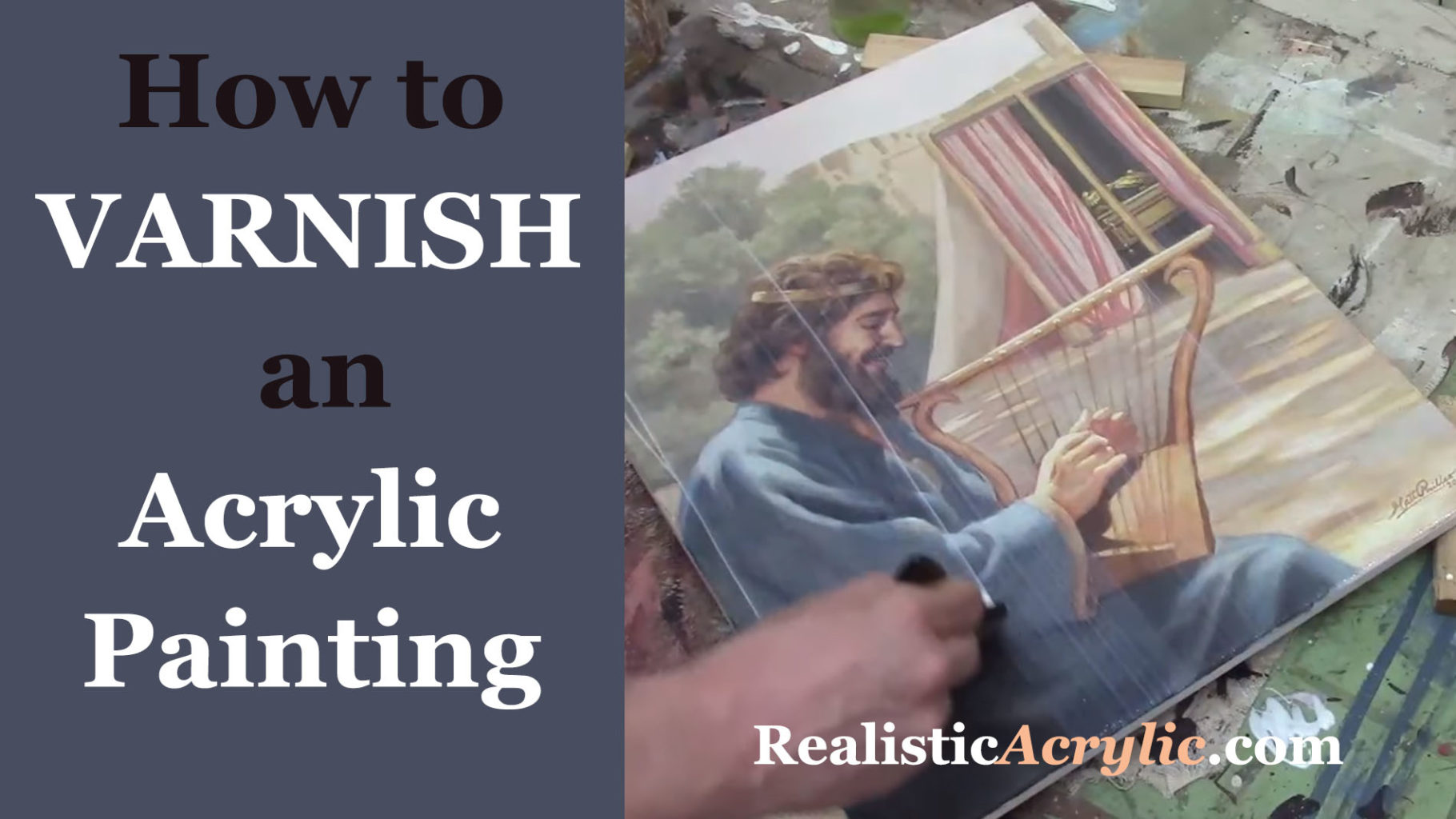
How to Varnish an Acrylic Painting in One Step
Discover the easy technique for how to varnish an acrylic painting in one step to enhance and preserve your artwork’s vibrancy
There’s a lot of controversy surrounding this topic, or at least, many different opinions on how to do it right.
Some say you need an isolation coat. But others say you should spray apply the varnish. And then there are some who pour it on or use a sponge!
I’m not here to dismiss any of those methods. If they work for that particular artist, more power to them.
Rather, I’d like to share with you the method I’ve been using for over 20 years as a portrait painter. And then it’s easy, and you can do it one step.
Let me break down this one-step acrylic varnishing method into how to actually do it…
- Lay your canvas flat on a table, oriented horizontally, but at an angle.
- Raise your canvas up, on four scraps of wood placed under each corner (make sure it’s level. 1″ x 2″s work well )
- Get your 4″ varnishing brush (Liquitex Freestyle works well)
- Pour matte varnish (Novacolor or Liquitex) into a clean yogurt container or any plastic container large enough to accommodate the width of the brush. Be sure to stir the varnish if it’s been sitting for a while! Over time the polymer resin can separate from the water in the mixture. If you don’t mix it, you may have streaks.
- “Sweep” any dust or debris off of the canvas surface with a large brush before you begin.
- Dip your brush into the varnish container, so the bristles are coated with varnish 1/3-1/2 of the way up from the tip.
- Begin brushing the varnish on the surface, starting with the end farthest from you. Brush in the longest direction of the canvas.
- Let your brush hit 1/3″ of the way from the left edge of the canvas. Apply even pressure and bring the brush all the way to the left edge.
- Bring the brush all the way to the right edge.
- Wipe any excess varnish that remains on your brush inside the top lip of your container.
- Flip the brush over and smooth out the entire first application, overlapping the edge slightly with 1-2 strokes. Do not overbrush!
- Dip your brush into the varnish container and repeat the process. Let your stroke slightly overlap the first (about 1/4″)
- You will be working your way toward your body. This will keep you from accidentally dripping onto the finished varnished surface.
- If you have any extra varnish that drips onto the side of the canvas, use a 3/4 flat brush to wipe it off. If the canvas will be framed, the side-drips are usually not a problem and can be left alone.
- Let your canvas dry flat on a table. It might look milky white in areas. Resist the temptation to brush it! If you followed my method, the varnish should dry crystal clear. It should dry completely within 3-5 hours, depending on humidity.
Disclaimer: I have used this method with great results in over 20 years of portrait painting. Because your results are up to you, how you apply this method, and the humidity levels of your studio space. I cannot be held responsible for any painting that gets damaged during the varnishing process. Then it would be a good idea to varnish a test piece first. You can add another layer (after 3-5 hours of dry time) if you feel the first one didn’t cover as well as you’d like, but most of the time, you won’t need to.
Watch this video below to see the process in action…
If you’re looking for more instructional videos on how to improve your acrylic painting, visit www.realisticacrylic.com for more tutorials and check out my free courses here. .
Let me know if you have any questions and I look forward to teaching you more!
LEARN MORE
- How to Paint Foliage Using the Acrylic Glazing Technique
- How to Trace for an Accurate Portrait Sketch
- How to Paint Realistic Eyes in Your Acrylic Portrait
- How to Add Raw Umber Dark & Ultramarine Blue to Your Portrait
- How to Make Your Own Raw Umber Dark
- How to Paint Realistic Trees & Grass in Your Acrylic
- How to Block In Skin Tone Values Using Glazing Technique
- How to Paint Vibrant Reds in Your Acrylic Portrait
- How to Glaze Background Colors & More Acrylic Portrait
- How to Paint White Clothing in Your Acrylic Portrait
- How to Easily Transition from a Sketch to a Painting
- How to Block In Shading & Skin Tones in Your Acrylic
- How to Build Up Color on Acrylic Pet Portrait
- How to Build Up Form on Clothing with Acrylic
- How to Paint Dark Clothing Using Acrylic Glazing Technique
- How to Paint a 24 x 30 Acrylic With 30 People
- How to Do Smooth Shading with Acrylic
- How to Sketch an Acrylic Portrait with a Grid
Read more about how to paint a portrait that you can surely be proud of!
I’d love to hear your thoughts about this video. Please share it with your friends and family. Let me know if you have any further questions. I’ll greatly help you.
If you’d like to learn more, sign up for my free email tips and video class today.
Learn How to Paint Acrylic Portraits With My Free Mini-Video Course!
Thank you so much for taking the time to read this tutorial and watch the video. That means a lot to me. I hope you find it very helpful in your portrait painting.
Yours for Better Portraits,

P.S. Did you find this post helpful or encouraging? If so, send it on ahead! Let others know with the share buttons below. I’d love to hear your comments. Thank you so much! Also, do you have a question on acrylic portrait painting you’d like answered? Let me know, and I’d be happy to help!
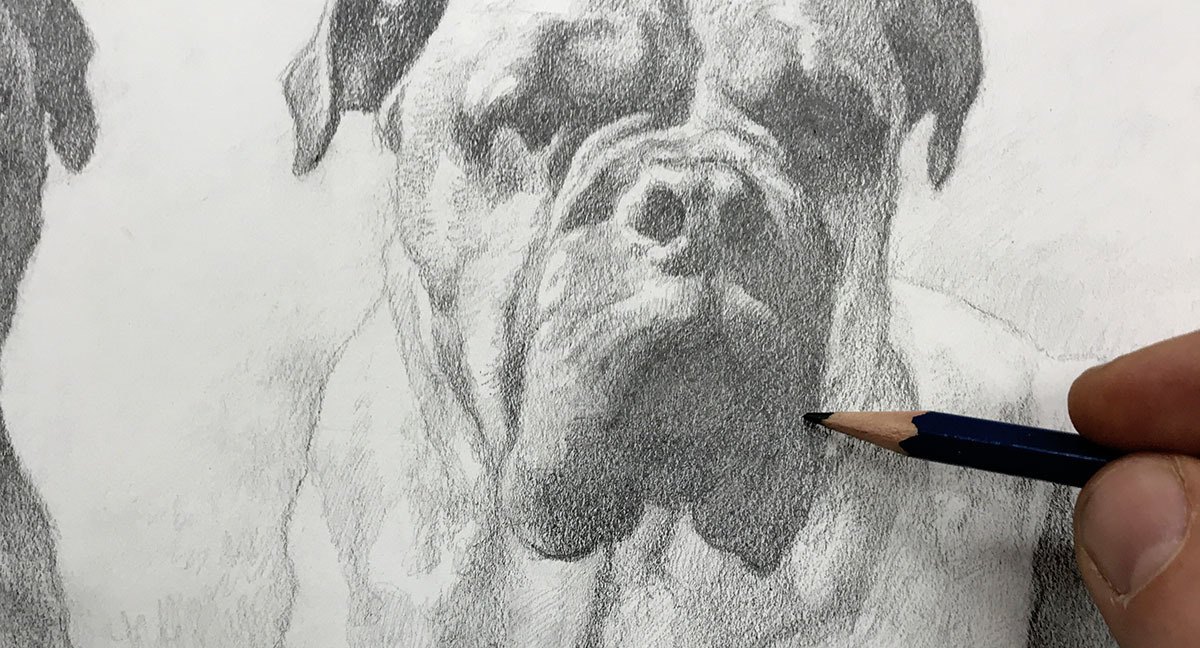
3 Tips on How to Draw Better Pencil Portraits
Unlock the secrets to realistic portraits with these essential pencil drawing techniques
Drawing realistic pencil portraits can be a rewarding yet challenging experience. If you’re looking to improve your pencil drawing skills, it’s essential to focus on technique, control, and mastering shading. Whether you’re a beginner or a seasoned artist, improving your pencil drawings can drastically boost your portrait painting skills, especially if you primarily work in acrylic. In this blog post, you’ll learn 3 valuable tips that will help you create lifelike pencil portraits.
1. Master Cross-Hatching for Realistic Shading
Cross-hatching is a time-tested technique that involves layering pencil strokes in a criss-cross pattern to build depth and texture in your drawings. In this method, parallel lines are drawn in one direction, and then a second set of lines is added at an angle across the first set. This overlapping of lines creates a rich texture and smooth tonal gradation.
To start, use a soft pencil like a 4B, which produces dark, rich tones. You’ll want to keep your pencil strokes close together, allowing minimal gaps between them. This technique is perfect for areas that require detailed shadowing, such as the contours of a face or fur on an animal. Then the secret lies in maintaining consistent pressure and evenly spacing your strokes.
To take it a step further, try cross-hatching at a 45-degree angle. Because this adds an extra layer of dimension and allows you to control the light and dark values more effectively. When shading, remember to follow the natural form of the subject to make the drawing appear more realistic.
By mastering cross-hatching, then you’ll find that your pencil drawings will have smoother textures and enhanced depth, making your portraits stand out with their intricate details.
2. Protect Your Drawing from Smudges
One of the biggest challenges when drawing with pencils is avoiding smudges. Then as you work, your hand can easily smudge the graphite, causing unwanted marks and ruining the clean lines of your portrait.
A simple yet effective way to prevent smudging is to place a piece of scrap paper under your drawing hand. Because this will act as a barrier between your hand and the drawing, keeping the graphite from smearing as you work. Not only does this keep the drawing neat, but it also prevents the natural oils from your skin from warping the paper.
It’s also important to work from left to right if you’re right-handed, or right to left if you’re left-handed, to reduce the risk of accidentally smudging what you’ve already drawn. Working in layers, starting with the lighter areas first, and finishing with the darkest parts will also minimize smudging.
By taking care to protect your drawing, you ensure that your portrait remains sharp and polished, free from unnecessary smears.
3. Blend with Tissue for a Smooth Finish
Blending is a powerful technique for smoothing out pencil strokes and achieving a soft, even tone. Many artists use blending stumps or their fingers, but using a piece of tissue paper offers a superior finish without over-smearing the details.
When you blend effectively, gently rub the tissue across the shaded areas of your drawing in small, circular motions. Then be careful not to press too hard, as this can overly blend the graphite and flatten the texture. And of course the goal is to lightly blend the surface to achieve smooth gradation between shadows and highlights.
One benefit of using tissue is that it preserves the texture of the paper underneath while softening the shading. This keeps the drawing realistic without losing detail. Additionally, after blending with tissue, you can go back and add more layers of pencil to intensify the values. This layering process creates richer depth in the drawing, allowing you to achieve darker areas without overworking the graphite.
By combining the precision of cross-hatching with the gentle blending of tissue, your portraits will exhibit a refined, professional quality, with smooth transitions between light and dark areas.
Technique Recap:
- Cross-Hatching: Start with closely-spaced, diagonal strokes at a 45-degree angle, layering them in opposite directions to create smooth, realistic shading.
- Prevent Smudging: Use a piece of scrap paper under your hand to keep the graphite from smearing, and work from top to bottom to avoid unintentional marks.
- Tissue Blending: Gently blend shaded areas with tissue for a polished look, allowing for added layers to deepen your values.
Conclusion:
Drawing better pencil portraits comes down to mastering basic techniques that bring out the realism in your work. With cross-hatching, careful blending, and preventing smudges, you can elevate your portrait skills and create lifelike, professional-quality art. Whether you’re sketching as a hobby or enhancing your painting skills, these pencil drawing tips will give you a solid foundation.
To keep improving, don’t forget to practice these techniques regularly. With time, you’ll see remarkable improvements in the depth, detail, and overall quality of your portraits.
Did you find these tips helpful? Be sure to subscribe to my YouTube channel for more art tutorials and visit my website, RealisticAcrylic.com, where you’ll find in-depth resources to help you create stunning portraits. Let’s bring your artwork to the next level!
Questions? Suggestions? Thoughts? Let me know, below in the comments. Please share this post with your friends!
- How to Paint Foliage Using the Acrylic Glazing Technique
- How to Trace for an Accurate Portrait Sketch
- How to Paint Realistic Eyes in Your Acrylic Portrait
- How to Add Raw Umber Dark & Ultramarine Blue to Your Portrait
- How to Make Your Own Raw Umber Dark
- How to Paint Realistic Trees & Grass in Your Acrylic
- How to Block In Skin Tone Values Using Glazing Technique
- How to Paint Vibrant Reds in Your Acrylic Portrait
- How to Glaze Background Colors & More Acrylic Portrait
- How to Paint White Clothing in Your Acrylic Portrait
- How to Easily Transition from a Sketch to a Painting
- How to Block In Shading & Skin Tones in Your Acrylic
- How to Build Up Color on Acrylic Pet Portrait
- How to Build Up Form on Clothing with Acrylic
- How to Paint Dark Clothing Using Acrylic Glazing Technique
- How to Paint a 24 x 30 Acrylic With 30 People
- How to Do Smooth Shading with Acrylic
- How to Sketch an Acrylic Portrait with a Grid
Read more about how to paint a portrait that you can surely be proud of!
I’d love to hear your thoughts about this video. Please share it with your friends and family. Let me know if you have any further questions. I’ll greatly help you.
If you’d like to learn more, sign up for my free email tips and video class today.
Learn How to Paint Acrylic Portraits With My Free Mini-Video Course!
Thank you so much for taking the time to read this tutorial and watch the video. That means a lot to me. I hope you find it very helpful in your portrait painting.
Yours for Better Portraits,

P.S. Did you find this post helpful or encouraging? If so, send it on ahead! Let others know with the share buttons below. I’d love to hear your comments. Thank you so much! Also, do you have a question on acrylic portrait painting you’d like answered? Let me know, and I’d be happy to help!
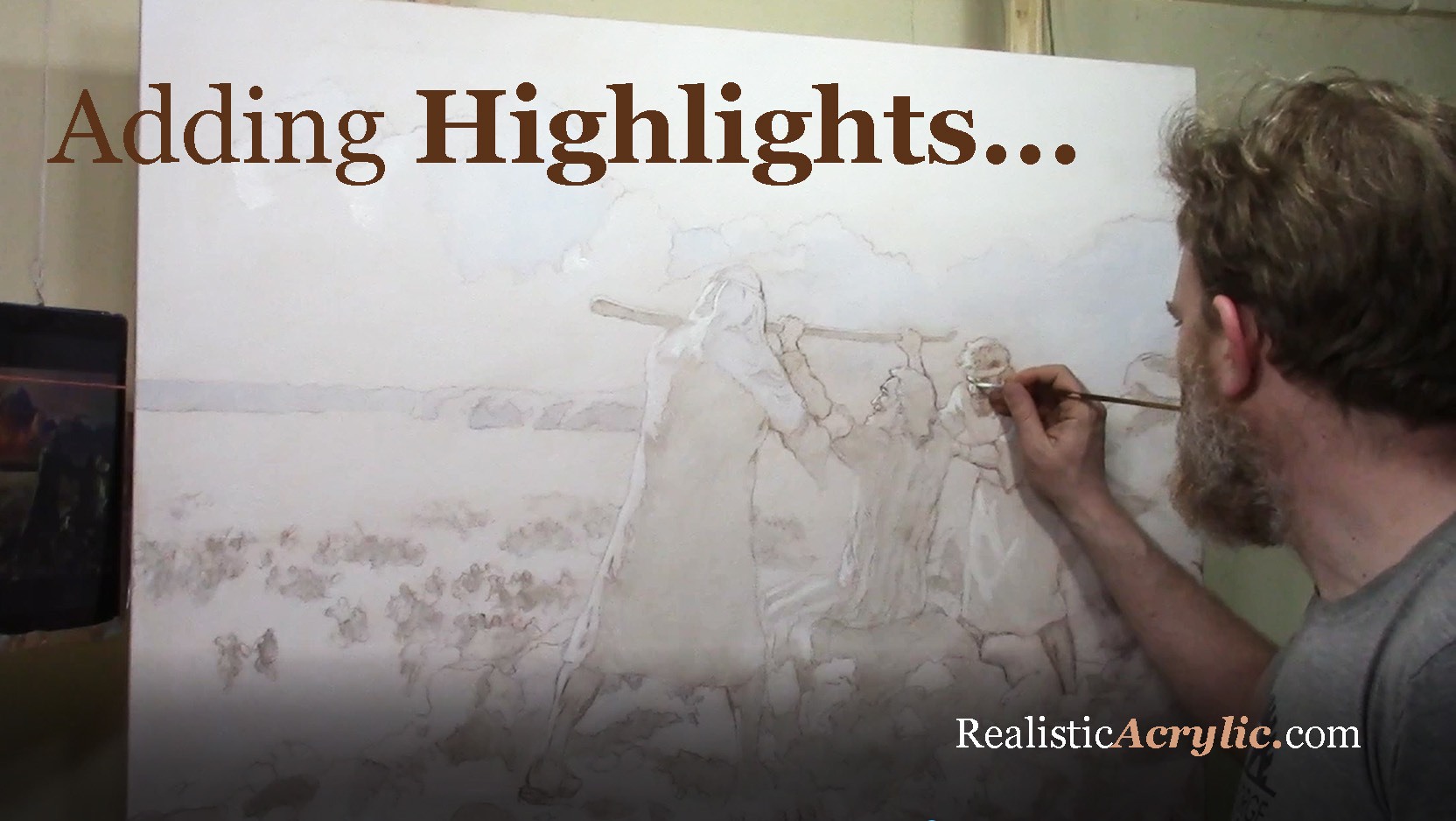
How to Add Initial Highlights to Your Acrylic Portrait
Unlock the secrets of applying initial highlights to your acrylic portraits for added depth and realism.
Adding highlights is a crucial step in bringing your acrylic portraits to life because it adds depth, dimension, and a sense of realism to the painting. In this tutorial, we’ll explore how to add initial highlights to your acrylic portrait after laying down a toning layer, using titanium white mixed with Indian yellow for a warm, vibrant touch. Then these highlights will help define the light source, making your portrait stand out.
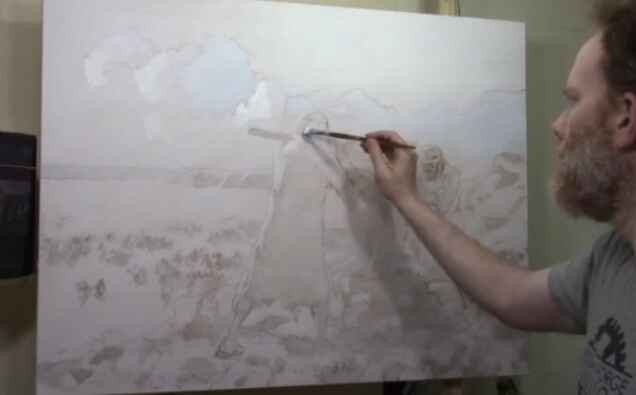
Materials You Will Need
Before we dive into the process, gather these materials:
- Titanium White Paint: For a bright, opaque base.
- Indian Yellow Paint: To warm up the white highlights.
- Matte Medium: Thins the paint for smoother application.
- Flat Size 14 Brush: Ideal for blocking in larger areas.
- Smaller Detail Brushes: Useful for adding precise highlights.
- Palette Knife (Optional): For mixing paint and mediums.
Step-by-Step Guide to Adding Initial Highlights
1. Mixing the Paint
The first step in adding highlights is preparing the right paint mixture. Because in this technique, we mix titanium white with a small amount of Indian yellow. Then the combination will create warm, natural highlights. So that the thin mixture with matte medium to around 50% opacity. This will also allow the highlights to blend seamlessly with the underlying layers without overpowering them.
Using matte medium ensures that the paint remains flexible and doesn’t dry too quickly, giving you ample time to work on the highlights.
2. Restoring Lost Highlights After Toning
After applying a toning layer, some highlights may have been muted or lost. Now it’s time to restore them. Start by focusing on the areas of your portrait where the light hits directly, such as the sky, the subject’s face, or their clothing. Then these areas need to stand out against the mid-tones and shadows.
Using the size 14 flat brush, gently block in the highlights. When you apply light, controlled strokes to ensure the paint doesn’t cover too much of the surrounding areas. Then keep your strokes smooth to avoid hard edges.
3. Adding Highlights to the Sky and Clouds
Begin with the sky and clouds, especially if you’re painting an outdoor portrait. Because when you apply the titanium white and Indian yellow mixture to the parts of the sky where the light source is strongest. This will create a glowing effect, giving the sky a more realistic appearance.
In this case, incorporating highlights into the clouds will help to define their shape and make them stand out from the background. Use soft brush strokes to add highlights along the edges, creating a gradual transition from light to shadow.
4. Highlighting Clothing
Next, move on to your subject’s clothing. Clothing often reflects light differently than skin, so it’s important to be mindful of texture. For smoother fabrics, such as silk or satin, use long, even brush strokes. Then for rougher fabrics like wool or cotton, stipple the highlights to mimic the texture of the material.
Start with broader highlights and then use a smaller brush to add more precise details, such as folds and creases. So remember that, these highlights should enhance the form of the clothing and help convey the fabric’s texture.
Techniques for Effective Highlighting
1. Build Gradually
When adding highlights, it’s essential to build up the light areas slowly. And then begin with lighter tones and gradually add more layers as needed. Because this ensures a more natural transition between highlights and shadows, enhancing the three-dimensional effect.
2. Focus on Light Source
Always keep the direction of the light source in mind. Highlights should reflect where the light is hitting the subject the most directly. In this tutorial, the highlights were added primarily to the face, clothing, and parts of the background, such as the sky and clouds.
3. Use Warm Colors for Depth
Instead of using pure white for highlights, adding a warm color like Indian yellow can create a more realistic effect. This warmth will help your highlights blend into the mid-tones and make the subject appear more vibrant.
Common Mistakes to Avoid
1. Overuse of Highlights
Too many highlights can make your portrait look flat and overexposed. Then focus on applying highlights sparingly in key areas where the light hits most directly. And less is often more when it comes to achieving a natural look.
2. Hard Edges
When applying highlights, avoid hard, defined edges unless you’re working on a very reflective surface like glass. Because most highlights, especially on skin and fabric, should have soft transitions to blend naturally with the rest of the painting.
Adding Final Details
As you finish applying the initial highlights, step back and observe your painting from a distance. This helps you see how the highlights interact with the rest of the painting and determine if they need any adjustments. If the highlights appear too bright or harsh, you can soften them by glazing over them with a thin layer of mid-tone color.
For areas like the face and hair, use a smaller brush to add subtle highlights that bring out the details. In the tutorial, highlights were applied to areas like the clothing, face, and even the sky to create depth and realism. For instance, on the subject’s face, highlights were applied to key areas such as the forehead and cheekbones, which receive the most light.
Conclusion
Adding initial highlights to your acrylic portrait is an essential step in creating depth and realism. By using a mixture of titanium white and Indian yellow, thinning it with matte medium, and applying it carefully to the key areas, you can restore lost highlights and breathe life into your portrait. As you continue to refine your highlights, remember to stay mindful of the light source, apply highlights gradually, and avoid overworking the painting.
Whether you’re painting a sky full of clouds or the fine details on a subject’s face, mastering the art of highlights will take your acrylic portraits to the next level.
For more tips and techniques on creating realistic portraits, visit www.realisticacrylic.com. Keep practicing, and you’ll soon be painting portraits you can be proud of!
Questions? Suggestions? Thoughts? Let me know, below in the comments. Please share this post with your friends!
- How to Paint Foliage Using the Acrylic Glazing Technique
- How to Trace for an Accurate Portrait Sketch
- How to Paint Realistic Eyes in Your Acrylic Portrait
- How to Add Raw Umber Dark & Ultramarine Blue to Your Portrait
- How to Make Your Own Raw Umber Dark
- How to Paint Realistic Trees & Grass in Your Acrylic
- How to Block In Skin Tone Values Using Glazing Technique
- How to Paint Vibrant Reds in Your Acrylic Portrait
- How to Glaze Background Colors & More Acrylic Portrait
- How to Paint White Clothing in Your Acrylic Portrait
- How to Easily Transition from a Sketch to a Painting
- How to Block In Shading & Skin Tones in Your Acrylic
- How to Build Up Color on Acrylic Pet Portrait
- How to Build Up Form on Clothing with Acrylic
- How to Paint Dark Clothing Using Acrylic Glazing Technique
- How to Paint a 24 x 30 Acrylic With 30 People
- How to Do Smooth Shading with Acrylic
- How to Sketch an Acrylic Portrait with a Grid
Read more about how to paint a portrait that you can surely be proud of!
I’d love to hear your thoughts about this video. Please share it with your friends and family. Let me know if you have any further questions. I’ll greatly help you.
If you’d like to learn more, sign up for my free email tips and video class today.
Learn How to Paint Acrylic Portraits With My Free Mini-Video Course!
Thank you so much for taking the time to read this tutorial and watch the video. That means a lot to me. I hope you find it very helpful in your portrait painting.
Yours for Better Portraits,

P.S. Did you find this post helpful or encouraging? If so, send it on ahead! Let others know with the share buttons below. I’d love to hear your comments. Thank you so much! Also, do you have a question on acrylic portrait painting you’d like answered? Let me know, and I’d be happy to help!
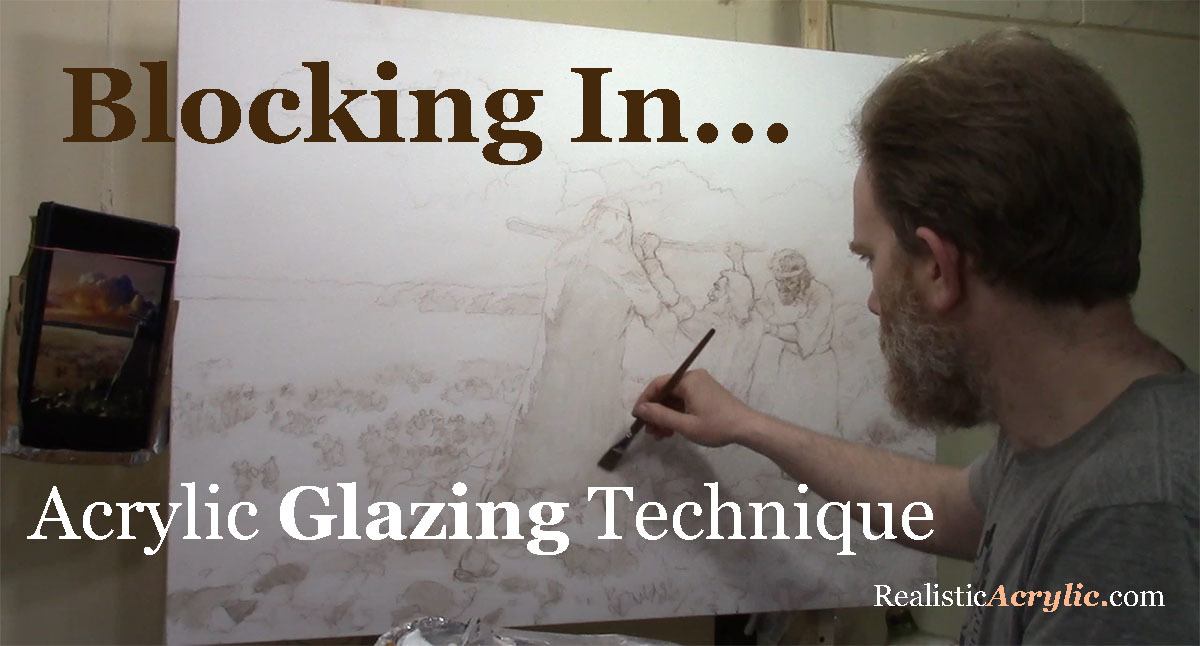
How to Blocking-in a 30″ x 40″ Acrylic Battle Scene Painting
Learn the technique of blocking-in a large 30″ x 40″ acrylic battle scene to establish strong foundations for your painting with depth and detail.
When tackling a large-scale project like blocking-in a 30″ x 40″ acrylic battle scene painting, the initial steps are crucial to setting the stage for a dynamic and cohesive composition. Because by using these combination of broad strokes and carefully placed color, this foundational layer helps you define the major forms, balance your composition, and create a sense of depth right from the start. Whether you’re an experienced artist or just starting out with larger works, mastering the blocking-in process will ensure your painting flows smoothly.
So in this demonstration, I am using a 30″ x 40″ acrylic painting I was commissioned to create, a battle scene between ancient Israel and the Amalekites. Then I asked my friends to come over to my home early in the morning, at sunrise, and model for the painting.

Yes, that’s me in the middle!
In this battle, when the Israelite leader Moses held up his staff, the power of God would flow. Then it caused the Israelite army to defeat their battlefield enemies. But, as the battle lasted for hours, Moses grew tired and couldn’t hold up his staff. Then the Amalekites got the advantage over the Israelites!
His assistants, Aaron and Hur came up with an idea. They had Moses sit on a rock. Then they held up his arms on either side, so once again, the Israelites could prevail.
This painting is meant to depict the struggle in praying, and how when others come alongside of us, they can ease the burden. And then their faith strengthens ours, and we can get the victory!
Here is my layout for the painting that I edited on Photoshop…

Now for the blocking-in video…
We start with an accurate sketch. Then, my goal is to quickly identify the major areas of contrast within the reference photo.
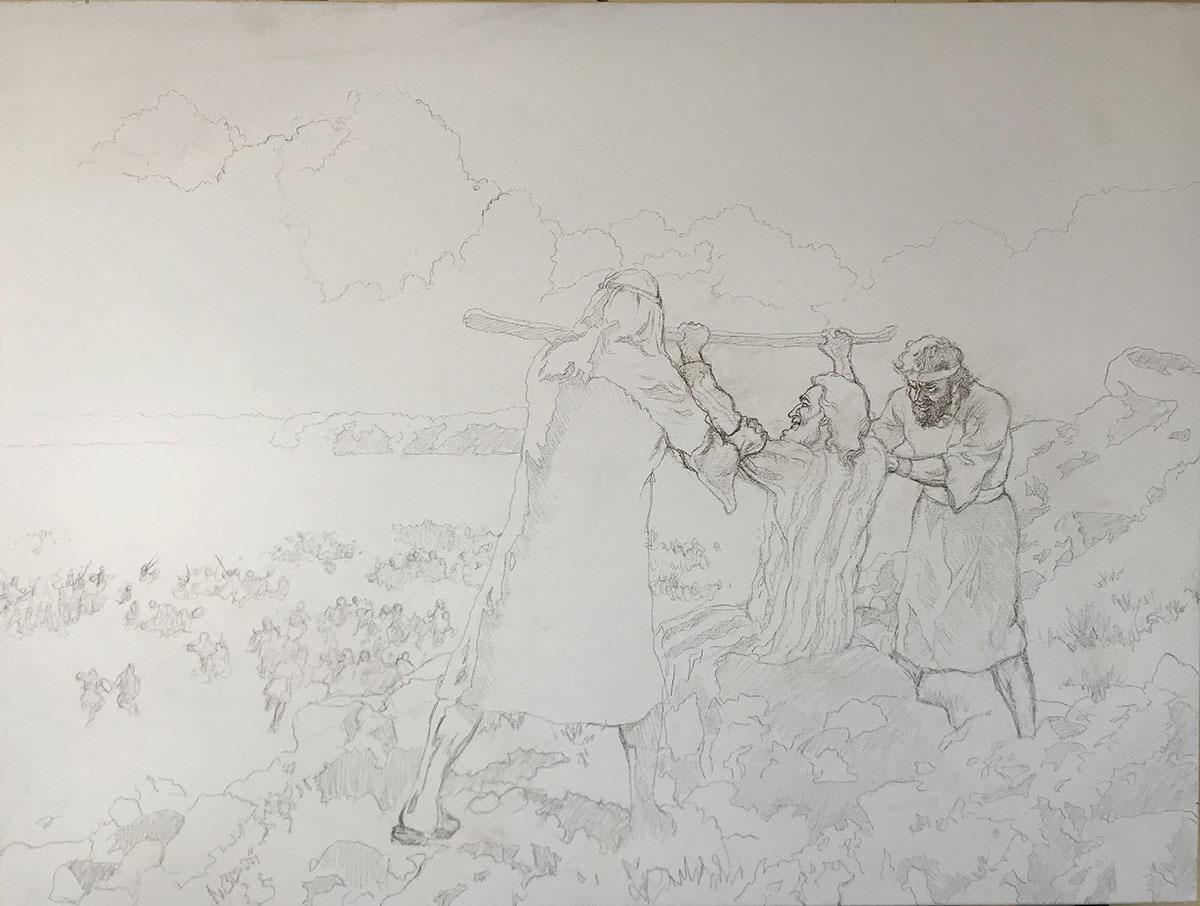
Then we apply a layer of raw umber dark, ultramarine blue and matte medium to the shadow areas designated on the sketch…
Tips and Techniques
- Start with Prayer & Purpose: Before beginning your painting, consider focusing on the purpose behind it. In this case, the painting represents a moment of intercessory prayer, symbolizing perseverance and spiritual victory. This mindfulness sets the tone for intentionality in your artwork.
- Use Matte Medium for Glazing: Apply matte medium to your palette before mixing in your colors. For blocking-in, ensure that your paint is heavily diluted with matte medium, aiming for a mixture that’s about 90-95% medium to 5-10% paint. This creates translucent layers, allowing for smooth blending and luminosity in the final work.
- Choose Your Colors: Use a traditional palette with earthy tones like raw umber, burnt sienna, and ultramarine blue, mixed with other colors such as titanium white for highlights. These colors create a natural, muted foundation for blocking-in shadows and light.
- Block-in Major Values: Start by blocking-in large value structures, such as the shadows on the figures and the surrounding landscape. Keep the application light to allow for adjustments later. Work across the whole canvas, focusing on dominant shapes and transitions between light and dark areas.
- Work with Large Brushes: Use larger, flat brushes, such as a three-quarter inch, to block-in broad areas quickly and efficiently. This prevents getting stuck in details too early, allowing you to build up the entire scene cohesively.
- Blend with Confidence: As you block-in, keep your brushstrokes fluid and in multiple directions to ensure smooth blending. Make sure to maintain a wet edge to avoid streaks and allow for easy adjustments.
- Don’t Fear Corrections: Because the paint is thin, any mistakes in the blocking-in phase can be easily corrected. You can always layer additional glazes or shift values as the painting progresses.
By focusing on blocking-in the large value structures early in the process, you create a solid foundation for your 30″ x 40″ acrylic battle scene, allowing the details to emerge naturally as you build layers.
If you’re interested in learning more about acrylic glazing or portrait painting techniques, be sure to explore the resources available at realisticacrylic.com. and download my free gift for you here.
Questions? Suggestions? Thoughts? Let me know, below in the comments. Please share this post with your friends!
- How to Paint Foliage Using the Acrylic Glazing Technique
- How to Trace for an Accurate Portrait Sketch
- How to Paint Realistic Eyes in Your Acrylic Portrait
- How to Add Raw Umber Dark & Ultramarine Blue to Your Portrait
- How to Make Your Own Raw Umber Dark
- How to Paint Realistic Trees & Grass in Your Acrylic
- How to Block In Skin Tone Values Using Glazing Technique
- How to Paint Vibrant Reds in Your Acrylic Portrait
- How to Glaze Background Colors & More Acrylic Portrait
- How to Paint White Clothing in Your Acrylic Portrait
- How to Easily Transition from a Sketch to a Painting
- How to Block In Shading & Skin Tones in Your Acrylic
- How to Build Up Color on Acrylic Pet Portrait
- How to Build Up Form on Clothing with Acrylic
- How to Paint Dark Clothing Using Acrylic Glazing Technique
- How to Paint a 24 x 30 Acrylic With 30 People
- How to Do Smooth Shading with Acrylic
- How to Sketch an Acrylic Portrait with a Grid
Read more about how to paint a portrait that you can surely be proud of!
I’d love to hear your thoughts about this video. Please share it with your friends and family. Let me know if you have any further questions. I’ll greatly help you.
If you’d like to learn more, sign up for my free email tips and video class today.
Learn How to Paint Acrylic Portraits With My Free Mini-Video Course!
Thank you so much for taking the time to read this tutorial and watch the video. That means a lot to me. I hope you find it very helpful in your portrait painting.
Yours for Better Portraits,

P.S. Did you find this post helpful or encouraging? If so, send it on ahead! Let others know with the share buttons below. I’d love to hear your comments. Thank you so much! Also, do you have a question on acrylic portrait painting you’d like answered? Let me know, and I’d be happy to help!
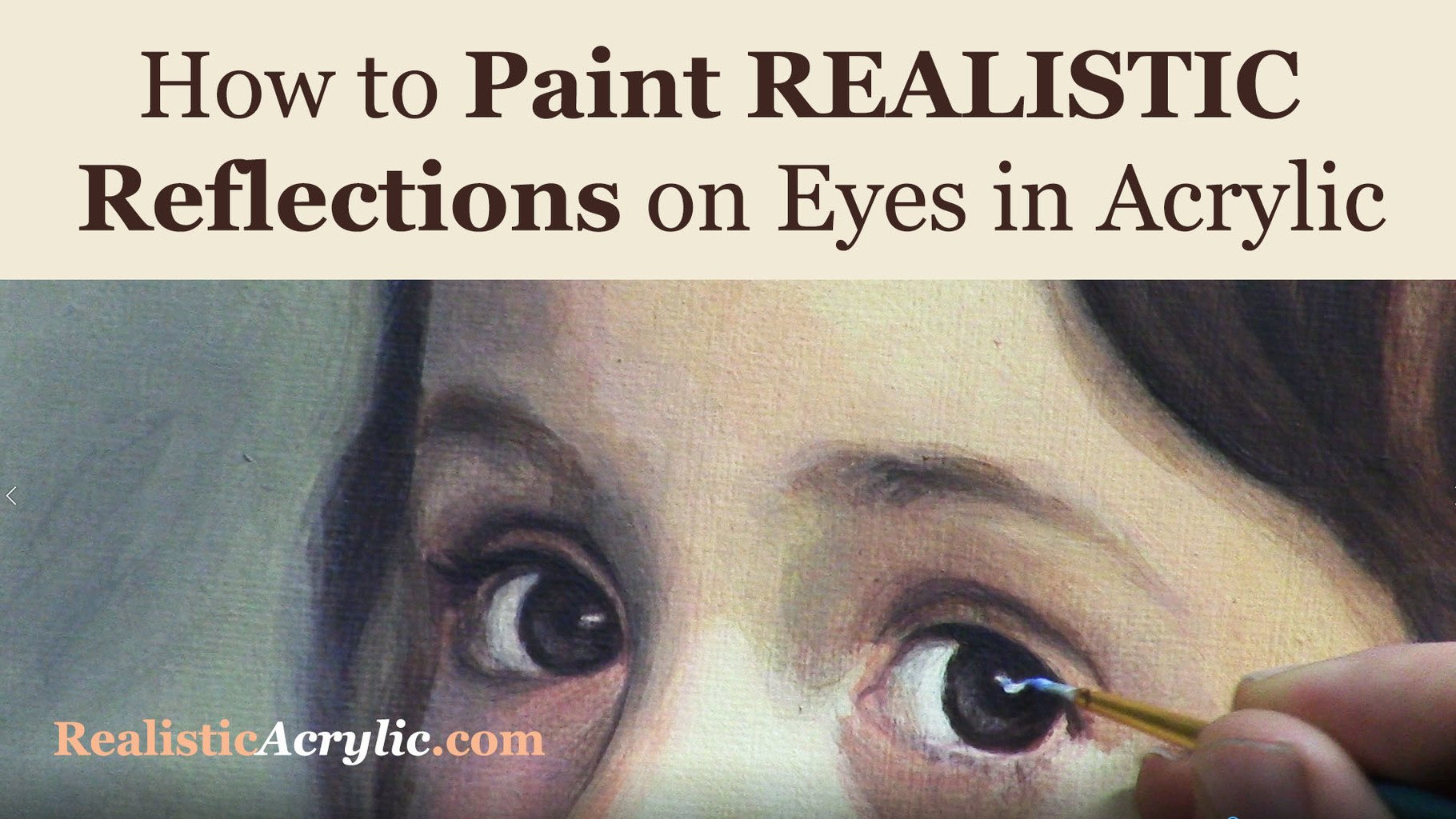
How to Paint Realistic Reflections on Eyes in Your Acrylic Portrait
Eyes are the most important feature of an acrylic portrait. When you paint the eyes correctly, everything else seems to fall into place so much easier.
In this video, I’ll show you how to paint realistic reflections, using two complementary colors in addition to white, and getting the shape of the reflection just right. Then this originally was a BONUS video in the Acrylic Portrait Painting Challenge Master Class, now available in the All-Access Membership at Realistic Acrylic Portrait School.
Even though it is technically over, you can take the Acrylic Portrait Painting Challenge (it’s FREE!) and paint along with us! 8 master class lessons are posted to help you paint a portrait you can be proud of!
REGISTER TODAY. The challenge is ongoing, something you can do at your own pace. It’s not too late to enter! After you join, I’ll send you the supplies list and reference photos to paint from.
Register for the Challenge!WATCH NOW…
Lesson #8: How to Paint Realistic Reflections on Eyes in Acrylic
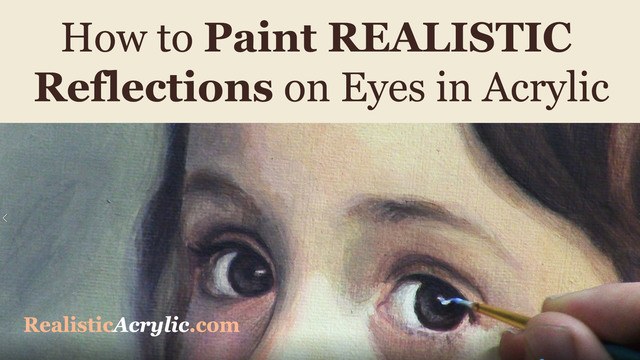
Questions? Suggestions? Thoughts? Let me know, below in the comments. Please share your sketches in our Facebook group and share this post with your friends!
- How to Paint Foliage Using the Acrylic Glazing Technique
- How to Trace for an Accurate Portrait Sketch
- How to Paint Realistic Eyes in Your Acrylic Portrait
- How to Add Raw Umber Dark & Ultramarine Blue to Your Portrait
- How to Make Your Own Raw Umber Dark
- How to Paint Realistic Trees & Grass in Your Acrylic
- How to Block In Skin Tone Values Using Glazing Technique
- How to Paint Vibrant Reds in Your Acrylic Portrait
- How to Glaze Background Colors & More Acrylic Portrait
- How to Paint White Clothing in Your Acrylic Portrait
- How to Easily Transition from a Sketch to a Painting
- How to Block In Shading & Skin Tones in Your Acrylic
- How to Build Up Color on Acrylic Pet Portrait
- How to Build Up Form on Clothing with Acrylic
- How to Paint Dark Clothing Using Acrylic Glazing Technique
- How to Paint a 24 x 30 Acrylic With 30 People
- How to Do Smooth Shading with Acrylic
- How to Sketch an Acrylic Portrait with a Grid
Read more about how to paint a portrait that you can surely be proud of!
I’d love to hear your thoughts about this video. Please share it with your friends and family. Let me know if you have any further questions. I’ll greatly help you.
Thank you so much for taking the time to read this tutorial and watch the video. That means a lot to me. I hope you find it very helpful in your portrait painting.

P.S. Did you find this post helpful or encouraging? If so, send it on ahead! Let others know with the share buttons below. I’d love to hear your comments. Thank you so much! Also, do you have a question on acrylic portrait painting you’d like answered? Let me know, and I’d be happy to help!
